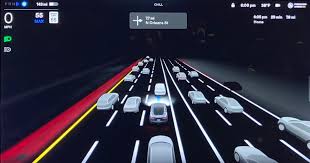
Unlocking Innovation: Tesla’s Machine Learning Revolution
The Intersection of Tesla and Machine Learning
Tesla, the renowned electric vehicle manufacturer, has been at the forefront of innovation in the automotive industry. One key aspect that sets Tesla apart is its extensive use of machine learning technology in its vehicles.
Machine learning plays a crucial role in Tesla’s autonomous driving features, such as Autopilot. Through the use of advanced algorithms and neural networks, Tesla vehicles are able to analyse and interpret data from sensors, cameras, and radar systems in real-time to make informed decisions while driving.
One of the most notable applications of machine learning in Tesla vehicles is its predictive capabilities. By continuously learning from vast amounts of data collected from millions of miles driven by Tesla cars worldwide, the system improves its ability to anticipate and react to various driving scenarios.
Tesla’s over-the-air software updates further demonstrate the company’s commitment to leveraging machine learning for ongoing improvements. These updates not only enhance existing features but also introduce new functionalities based on insights gained from data analysis.
The Future of Tesla and Machine Learning
As Tesla continues to push boundaries in electric vehicle technology, machine learning will undoubtedly play a significant role in shaping the future of transportation. The integration of AI-driven capabilities not only enhances safety and efficiency but also paves the way for fully autonomous driving.
With each advancement in machine learning algorithms and hardware capabilities, Tesla stands poised to revolutionise the automotive industry further. The synergy between Tesla’s innovative spirit and cutting-edge machine learning technologies promises a future where intelligent vehicles redefine how we perceive transportation.
Understanding Tesla’s Use of Machine Learning and AI: Key FAQs
- What is the Tesla learning algorithm?
- How is AI being used in Tesla?
- How Tesla is using AI and ML?
- Does Tesla use machine learning?
- Does Tesla have machine learning?
What is the Tesla learning algorithm?
The Tesla learning algorithm refers to the sophisticated machine learning technology utilised by Tesla in its vehicles, particularly in the development of autonomous driving features like Autopilot. This algorithm enables Tesla cars to continuously gather and analyse data from various sensors, cameras, and radar systems to make real-time decisions while on the road. By leveraging neural networks and advanced algorithms, the Tesla learning algorithm enhances the vehicle’s ability to learn from its surroundings and predict and respond to different driving scenarios effectively. Through ongoing updates and improvements, Tesla is at the forefront of integrating cutting-edge machine learning capabilities into its vehicles, setting new standards for intelligent transportation systems.
How is AI being used in Tesla?
Artificial Intelligence (AI) is integral to Tesla’s operations, particularly in enhancing the capabilities of its vehicles. Tesla uses AI primarily for its Autopilot and Full Self-Driving (FSD) features, which rely on advanced machine learning algorithms to interpret data from the car’s array of sensors, cameras, and radar. This enables real-time decision-making for navigation, obstacle detection, and traffic management. Additionally, AI helps improve vehicle performance through over-the-air updates that continuously refine driving algorithms based on data collected from millions of miles driven by Tesla vehicles globally. This ongoing learning process allows Tesla cars to become progressively smarter and more adept at handling diverse driving conditions autonomously.
How Tesla is using AI and ML?
Tesla leverages artificial intelligence (AI) and machine learning (ML) to enhance its vehicles’ autonomous driving capabilities and overall performance. The company utilises AI-driven algorithms to process vast amounts of data collected from its fleet, enabling real-time decision-making for features such as Autopilot. Machine learning models are trained on this data to improve object detection, lane recognition, and path planning, allowing Tesla cars to navigate complex driving environments with increasing accuracy. Furthermore, Tesla’s use of over-the-air software updates ensures that the AI systems in its vehicles continually evolve, incorporating new insights and improvements derived from global driving experiences. This dynamic approach positions Tesla at the cutting edge of automotive innovation, paving the way towards fully autonomous vehicles.
Does Tesla use machine learning?
Yes, Tesla extensively utilises machine learning in its vehicles to power various features, particularly in its autonomous driving technology. By harnessing advanced algorithms and neural networks, Tesla’s vehicles can analyse data from sensors, cameras, and radar systems in real-time. This enables them to make informed decisions while driving and continuously improve their performance through predictive capabilities. Tesla’s commitment to leveraging machine learning is evident in its over-the-air software updates, which not only enhance existing features but also introduce new functionalities based on insights gained from data analysis. Through the integration of AI-driven technologies, Tesla is at the forefront of transforming the automotive industry and paving the way for a future of intelligent and autonomous vehicles.
Does Tesla have machine learning?
Yes, Tesla incorporates machine learning extensively in its vehicles, particularly in the development of its autonomous driving features like Autopilot. Tesla’s use of advanced algorithms and neural networks allows its vehicles to analyse data from various sensors and make real-time driving decisions based on that information. Through continuous learning from vast amounts of driving data collected globally, Tesla’s system improves its predictive capabilities and enhances safety on the road. The integration of machine learning in Tesla cars showcases the company’s commitment to innovation and technology-driven advancements in the automotive industry.
